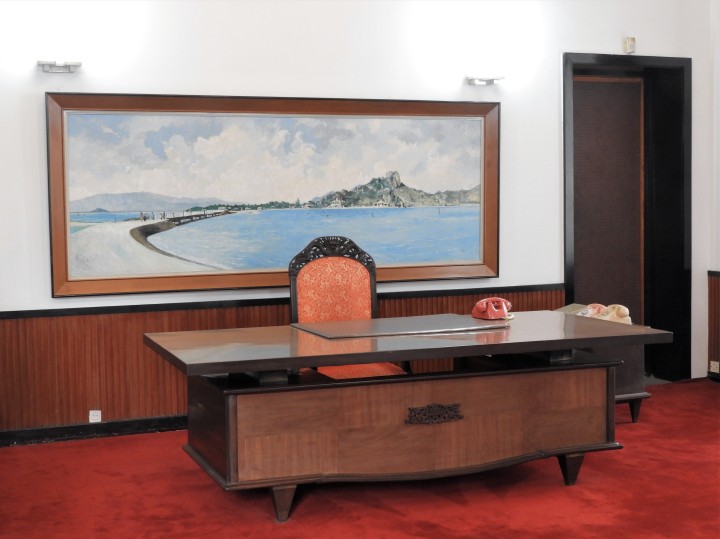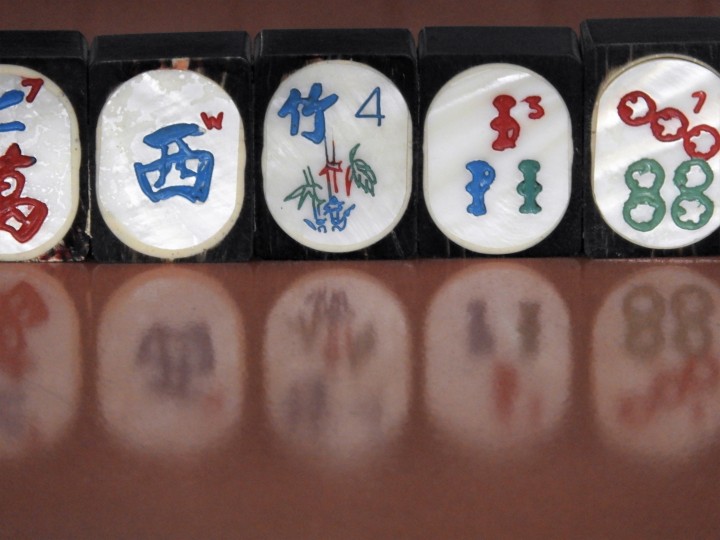Saigon. December 2019
I didn’t know much about Vietnamese history. But I did know that the Reunification Palace is a bit of a must for history buffs. We’d walked past it a few times. A 1960’s ugly block of a building, which cast a sort of eerie shadow over the city, palm trees and manicured gardens notwithstanding.

When we visited I had the approach and the front steps to myself. The after-lunch tourists were still at lunch. It’s size was imposing and the architecture striking, but it was a sense of what had gone before that slowed my steps. On the 30th April 1975 a soldier ran up the stairs I was treading, unfurled the VC flag from the balcony, and then went to meet General Minh who had become head of the South Vietnamese state only 43 hours before. ‘I have been waiting since early morning to transfer power to you’, Minh is supposed to have told him. ‘There is no question of your transferring power’, replied the soldier, ‘you cannot give up what you do not have’. Later, they all sat down to a dinner of rice and NVA-ration canned beef – the first banquet of the new regime, in the Reunification Palace of Ho Chi Minh City.


At the top of the steps, a chasm of an entrance hall and meeting room upon meeting room, tables to seat seeming multitudes, suite upon suite of chunky unwieldy furniture and acres of carpet. Up close the architectural design was beautiful, a symphony of geometric pattern, light, shadow and symbolic reference. Colonnaded rooms open to interior courtyards, allowed the occasional cooling breeze to flutter shirts and skirts and offer a momentary respite from the unrelenting heat.


The palace, with it’s 95 rooms, is a labyrinth. I tracked up and down stairs, hemmed in by an ever-increasing number of people. On the first floor, reception rooms for foreign and national dignitaries. And at the back, President Nguyen Van Thieu’s living quarters. It was his predecessor, President Ngo Dinh Diem, who instigated the building of the palace after his own air force bombed the former French palace that stood on the site, in an unsuccessful attempt to kill him. Diem ordered the building of a new residence – with basement bomb shelter – but died before it’s completion in 1966. (He was killed by his own troops in 1963). Madame Nhu – Diem’s sister-in-law and the de facto first lady of South Vietnam because of Diem’s unmarried status – after choosing the chandeliers, carpets and curtains for all those rooms, must have been furious.
Thieu stayed in the palace throughout the war. On April 21, 1975, as the communist forces were homing in on Saigon, he fled. Then came the purblind seven-day president, Tran Van Huong, followed by the 43-hour president, General “Big” Minh.
In all this colossal impersonal space, once in a while there was a glimpse of personality. Behind President Van Thieu’s desk, a large and lovely pastel-coloured painting of his home town. I was rather taken with the pale rose and avocado telephones. They seemed out of place in this tale of power struggle, war, bombing and murder. The second floor was delicious in it’s cheesiness. As the Lonely Planet says ‘James Bond/Austin Powers – eat your heart out’. A card playing room, complete with round leather sofa, and barrel bar, adjoins a cinema room, all red velvet plush and black leather quilted doors. And of course, there was a rooftop night-club complete with helipad. A Huey stands ready.





After that frivolity it was down to the basement with it’s telecommunications centre, war room and rabbit-warren tunnels. More clunky austerity, plain furniture, dated equipment, bulky devices, dials, switches and knobs, faded strategy maps and rows of telephones. Pins in maps, pie in the sky, south against north, truth and lies, civil war, and a whiff of desperation. Those narrow grey corridors fairly rang with it.


My head rang. My heart beat fast. The Reunification Palace is an emotional roller-coaster ride: horror – the war was brutal and tragic and conducted from here – and rapture, at it’s retro beauty. Quite a history lesson, with a bit of quirk and a lot of aesthetic thrown in.





Many thanks for the guided tour.
LikeLike
Thank you for reading.
LikeLiked by 1 person
The pleasure’s all mine
LikeLike
Wow, what a fascinating trip into the Twilight Zone. It’s like something from an early science fiction novel.
LikeLike
Yep, it was definitely an out of this world experience!
LikeLiked by 1 person
I missed this one when I was there. Looks well worth visiting!
LikeLike
Certainly is. We spent a whole day there, pottering about. You need stamina though. It’s so hot, and there’s no air co…
LikeLike
Wow, it looks so sterile and bleak. That would definitely be an interesting visit when in Vietnam.
LikeLike
It was Lorelle. The whole place kind of pressed down on me a bit. But it’s also quite beautiful in a grim sort of way.
LikeLiked by 1 person
I totally get it Tracey. It would be very intriguing.
Have a great week 😊
LikeLike
You too Lorelle, stay lockdown strong!
LikeLike
It does have its own unique beauty, and the history is just fascinating. What an incredible tour this must have been.
LikeLike
Thanks Dee. It was one of the most memorable things we did in Saigon.
LikeLike